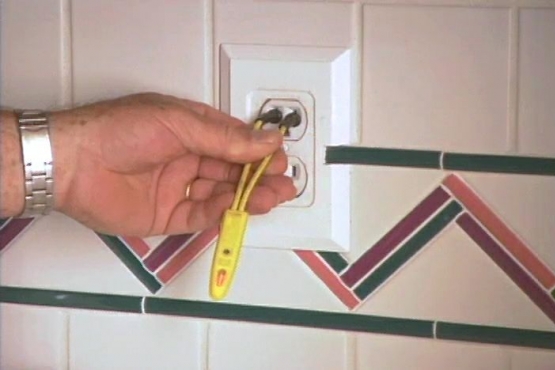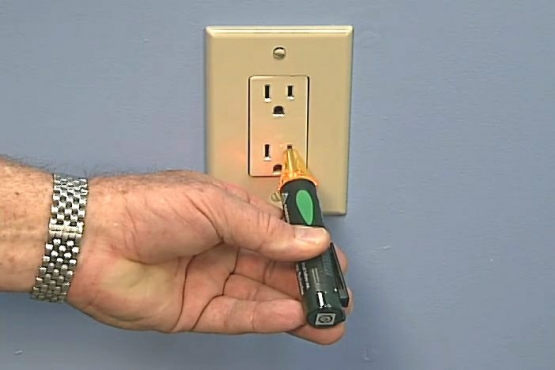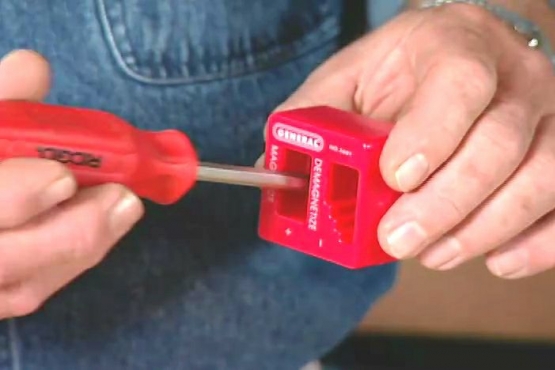RON HAZELTON:
Now, which TV gets the most use of any in the house? Well, this one right here in the kitchen. My wife and I watch this, the kids are always in here. In fact, this TV is in use almost all day long, and yet it's the least high-tech television we have, and the smallest screen, plus it takes up a lot of valuable countertop space.
Well, I'm gonna change all that today. I'm gonna upgrade this to a hi-def set and I'm gonna solve the countertop clutter problem. Last year, Sean Cutrufo set up a home theater for me that the family and I have thoroughly enjoyed.
This morning, he's coming back to give me a hand with the kitchen project.
[DOORBELL]
Bud, did you have a good trip?
SEAN CUTRUFO:
Yeah, I did, how are you?
RON HAZELTON:
Come on in. Now here's the culprit right here. You know, really what I want, I want as big a screen as I can find -- that will, can fit in here, the best quality picture, and I'd like to get the stuff up off the countertop. The cable box, the DVD player, all that kind of thing.
SEAN CUTRUFO:
Well, that's a great idea. The best bet right now would be to go with a 16 x 9 TV -- a wide screen TV. We can fit it right up and underneath this cabinet. We can take the DVD player and the VCR and the cable box, stick them all inside the cabinet right on the shelves, we can close it right back up, put a little sensor on the TV and run the signal right up into the cabinet.
RON HAZELTON:
So I don't then have to open the doors to use the remote?
SEAN CUTRUFO:
No, not at all.
RON HAZELTON:
I like that.
SEAN CUTRUFO:
The only thing, though, is -- we're gonna have to start off with putting the cable wire and the electricity into the cabinet.
RON HAZELTON:
Okay.
Ray Hernandez has helped me out with a lot of electrical projects. I've asked him to run both electricity and cable inside the cabinet. First he traces the junction box outlines, then uses a three-quarter-inch spade bit to drill starter holes for each box.
[DRILL NOISE]
Using a reciprocating saw, he makes the cutouts. Down in the basement, Ray feeds an electrical fish tape up into a hole he's drilled through the base plate at the bottom of the wall. Then he goes back upstairs to retrieve the end of the metal tape by reaching into the cutout. Now he tapes the electrical wire and television cable onto the opposite end of the fish tape. Notice how he twists the tape before breaking it.
Then he feeds the wire bundle into the hole -- and pulls everything up into the kitchen. Now he feeds the cable through the back of the box, and sets the box in place in the wall. Then he does the same thing with the electrical wire and box.
As he turns the screws on either side, small arms flip out inside the wall cavity. Continued turning draws the arms into contact with the back side of the wall, securing the boxes in place. Finally, he strips the insulation from the electrical wires, attaches them to the terminals on the receptacle, folds the wires carefully, pushes the outlet into the junction box, and secures the mounting screws.
Now it's Sean's turn. He strips the insulation off the end of the coaxial cable, slips on a connector and uses a crimping tool to attach the connector permanently to the end of the cable. Then he installs the cover plates on both boxes. When we come back, we'll put in a TV that's picture perfect for the kitchen and guaranteed to keep the counter clutter-free.
Now it's time to bring in the new set. While Sean and Ray have been doing the critical work, I've been out shopping.
The new hi-def flat panel television set comes set up for tabletop use. First, Sean removes the handle on the back -- then unscrews and takes off the base that allows the set to be freestanding. Next, he removes the covers concealing the terminals.
Then connects the new mounting bracket that will attach to the underside of the cabinet, using the same screw holes that were originally intended for the handle. Now he removes the bracket base, holds it in position, and marks the location of the mounting holes.
The bracket will be attached using bolts, rather than screws. Three holes are bored through the cabinet bottom. Threaded inserts are dropped in from the top. Then the bolts are inserted through the base and screwed up from the bottom, where they engage the inserts.
Next, Sean uses a hole saw to bore an opening that will allow cables to be run from the equipment in the cabinet to the TV below. First, he connects the cables to the DVD and cable box. Then [he] sets the equipment in place and feeds the lines through the hole, which needs to be large enough to accommodate not only the cables but also the connectors on the ends. Now what's going to allow me to operate the cable box and DVD player with the cabinet door closed is this remote sensor. It's being installed in the cabinet face frame and will communicate with any remote control device.
Finally the cables are connected to the TV --and the mounting bracket is secured to the base. The remote control units will send infrared signals to the receiver in the cabinet face. The receiver will pass those signals along to these tiny emitters that will in turn, flash the infrared information to the cable box and DVD player.
With all the hookups complete, the last of the wiring is tucked into this box, which serves as a base for the components. A removable cover conceals the wires but leaves them accessible.
Wow, I really like that.
SEAN CUTRUFO:
What do you think, pretty good, huh?
RON HAZELTON:
Very nice.
SEAN CUTRUFO:
And what's nice is, we didn't take up any room in your cabinet. You got your cable box, your DVD player and a little box that hides all the wiring. Just slide this panel over, you can access all the wiring for any repairs or upgrades, slide it back, close it up, disappears.
And the sensor right here, brings all of the signals back up into the cabinet so you don't have to have the doors open.
RON HAZELTON:
Wow.
SEAN CUTRUFO:
Turn the TV this way while you're washing your dishes, turn it back the other way and you can watch it at your table.
RON HAZELTON:
Beautiful. And you know what, we cleared up all of this counter space.
LYNN:
We’re so excited for Ron’s birthday party --
[SOUNDS OF KIDS' VOICES]
RON HAZELTON:
Look at this, huh?
LYNN:
Ah, look at that.
RON HAZELTON:
Well, like a good many families, we spend a lot of time in our kitchen. Now we've got a TV that's versatile enough to allow us to catch the news while we're preparing a meal, or share a movie over a bowl of popcorn. [LAUGHS] Well, so much for the sharing part.









